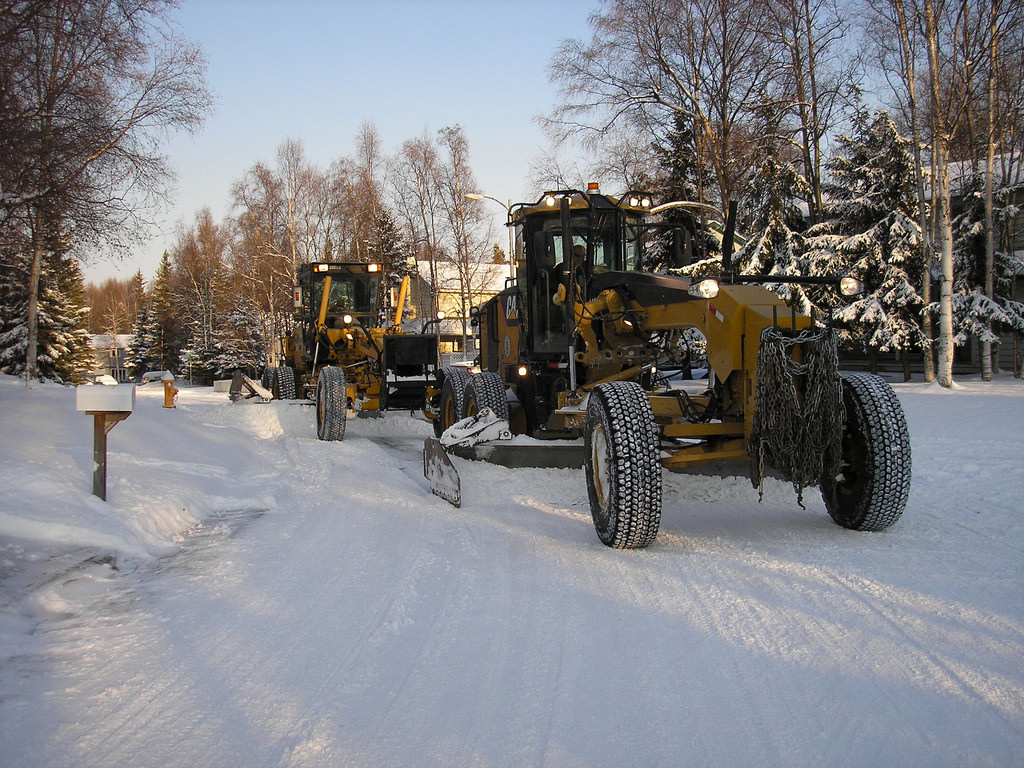November 9th, 2015
 Winter weather has fully arrived and with it the Anchorage municipality is offering an online map tracking the city’s efforts to keep the roads clear.
Winter weather has fully arrived and with it the Anchorage municipality is offering an online map tracking the city’s efforts to keep the roads clear.
“We can’t control the weather, but our new map provides Anchorage residents with plow plans and real-time updates for roads the municipality maintains, as well as contact information for state-maintained arterials and streets,” Mayor Ethan Berkowitz said in a Monday statement announcing the new map.
City employees are responsible for approximately half of the paved roads in Anchorage—1,300 lane miles of road, 1,400 cul-de-sacs and 200 miles of sidewalks and trails.
Anchorage maintenance equipment included 30 graders, 9 sander truck and 2 de-icer vehicles.(2015)
Of note: Anchorage de-icer vehicles use magnesium chloride rather than salt (sodium chloride) due to environmental concerns. Saltwater runoff can contaminate soil and leach into rivers and lakes damaging salmon habitat. Electrolytes from saltwater increase the rate at which metals will rust.
Interactive map: Snow Plowing in Anchorage
November 4th, 2015
Brace yourselves! Winter is coming! No, not the fun Game of Thrones winter. The real deal: dark, endless Alaskan winter. Long, dreary, and cold. So cold. Cold, snowy, and icy. And you’ve got to drive in it. It’s not my idea of a good time and probably not yours either, but unless you have a half year of dry goods, bottled water, and toilet paper packed into the garage, plus a very understanding employer and really amazing wireless, you don’t have much choice. On the plus side, there are things you can do to make it a little less painful.
At this point, you’ve either switched to snow tires (legal starting September 15 in Anchorage) or you’re planning to make it through the season on all-weather radials. (If you’re still planning to switch to snow tires, you might want to get to it. Because … uh … WINTER IS COMING.)
Anyway, for the sake of this post, we’ll assume that you’ve got the tires you’ll have. Still, there’s some good prep you can do to keep yourself safe and warm and your car in good working order, which is the first step to a good driving experience. Safety first, kids! Before you get in the car (like, the day before):
- Those tires we were talking about? Make sure they’re properly inflated. Makes a huge difference in how the car handles, not to mention how long the tires last.
- Keep your gas tank at least half-full in cold weather to prevent the freezing of fuel lines.
- If you’re driving a diesel, make sure it stays warm enough to start by using block heaters and/or other methods.
- If you’re going to be driving out of town, it’s a good idea to have blankets, food, water, and any necessary medications in the car in case you get stuck.
And then shortly before you hop in your car to go:
- Never warm up your vehicle in an enclosed space like a garage. Because carbon monoxide.
- It’s also not a great idea to warm your car up outside by starting it and leaving the keys in it. That’s a good way to get your car stolen. A better option: remote start.
- Dress warmly, or at least take a coat and gloves with you. Maybe you’re just in town, but if it’s 15 degrees and you end up having to walk a half mile because you slid into a curb or ditch, a sweater isn’t going to cut it. You probably won’t freeze to death, but you’ll be pretty miserable, and you could end up with frostbite or worse.
Hey, you’re in your car, FINALLY!
- Great! Now, fasten your seat belts. Before you even shift into gear, make sure you and all your passengers are safely buckled in. I think most people do this by now, but a little reminder never hurt.
- Woo hoo! You’re moving! If you’re moving on snow or ice, though, go more slowly than usual. Allow more time for EVERYTHING because everything will take longer. (Just imagine snow and ice as a whiny toddler hanging on your legs as you try to walk. It’s like that.) Stopping. Starting. Turning. It’s just slower. Gentle pressure on the gas pedal, gentle pressure on the brakes.
- Speaking of stopping, don’t. If you can help it, don’t stop. Coming up to a red light? Slow down and see if you can hit it green. It’s much easier to keep going at a slow pace than to stop and start again on slick pavement. Inertia is a harsh mistress.
- But if you have to stop, in the name of all that you believe in, do not stop while going uphill. Do. Not. Just don’t.
- And perhaps most importantly: if you begin to slide into a curb or ditch or the nearest McDonald’s, avert your eyes! That’s right. Don’t look at the thing that your brain desperately wants you to look at. Point your eyes where you want to go (which typically would be the street). It’s science, people. Believe.
So, suppose you fail in your attempts and end up hitting another car or sliding into a ditch anyway. What now? Well ... now you wait until my next post. But seriously, try not to do that, k? Be safe.
Written by: Evelyn Stice
 Winter weather has fully arrived and with it the Anchorage municipality is offering an online map tracking the city’s efforts to keep the roads clear.
Winter weather has fully arrived and with it the Anchorage municipality is offering an online map tracking the city’s efforts to keep the roads clear.
